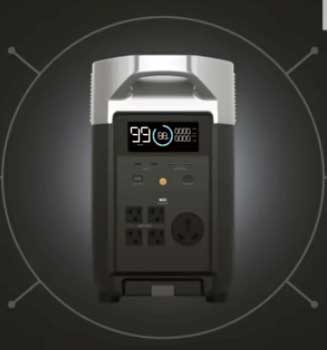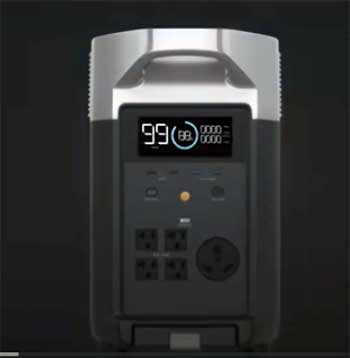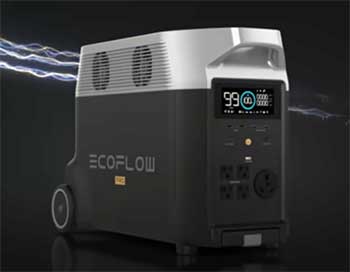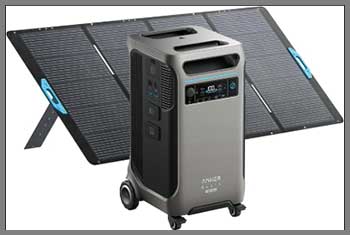Ever felt that knot in your stomach when the power flickers during a storm, leaving your fridge humming in vain and your work grinding to a halt? As someone who’s wrangled with blackouts in my rural cabin and powered weekend camping trips, I’ve chased reliable backup solutions that don’t break the bank or the back.
In this article, I compare the EcoFlow DELTA Pro and Anker SOLIX F3800—two beasts in portable power stations—focusing on their capacity, output, expandability, and real-life reliability to help you pick the winner for home backups, RV adventures, or off-grid escapes.
Comparison Table Ecoflow Delta Pro And Anker Solix F3800
| Feature | EcoFlow DELTA Pro | Anker SOLIX F3800 |
| Capacity | 3.6kWh (expandable to 25kWh) | 3.84kWh (expandable to 26.9kWh) |
| AC Output | 3.6kW continuous (7.2kW surge) | 6kW continuous (9kW surge) |
| Solar Input | 1.6kW max | 2.4kW max |
| Weight | 99 lbs | 132 lbs |
| Ports | 5 AC, 2 USB-A, 2 USB-C, 2 DC | 6 AC (120V), 2 AC (240V), 2 USB-A, 3 USB-C, 2 DC |
| Battery Type | LiFePO4 (3,000+ cycles) | LiFePO4 (3,000+ cycles) |
| Charge Time (AC) | 2.7 hours full | 2 hours full |
| Price (Base) | $2,699 | $3,999 |
| Warranty | 5 years | 5 years |
My Experience With Ecoflow Delta Pro

I remember the first time I wheeled the EcoFlow DELTA Pro into my garage after a brutal winter storm knocked out power for three days straight.
At 99 pounds, it wasn’t a feather, but those built-in wheels made it feel like rolling a stubborn suitcase rather than lugging a boulder.
I hooked it up to my cabin’s essentials—fridge, lights, a small heater—and watched the app light up with real-time stats, showing me exactly how much juice it was sipping.
That night, as winds howled outside, the DELTA Pro kept my family warm without a single hiccup, powering through 3.6kWh like it was built for it.
Over the next few months, it became my go-to for everything. On a fishing trip up north, I paired it with two 400W solar panels, and by midday, it was topped off, running my coffee maker and charging phones for the whole group.
The 3.6kW output handled my electric grill without breaking a sweat, surging to 7.2kW when I accidentally overloaded it with a blender. But let’s be real, the weight made solo transport a workout; I cursed those stairs to the attic more than once.
Fast-forward to summer RV outings. I expanded it with an extra battery, pushing capacity to 7.2kWh, and it transformed my trailer into a mobile fortress. Air conditioner humming, microwave beeping— all on solar recharges that took under two hours in full sun.
The app’s customization let me prioritize loads, like saving power for the CPAP machine during naps. Yet, during a rainy week, solar input lagged at 1.6kW max, forcing me to lean on the AC charger more than I’d like. Still, its quiet operation—no fan roar like gas generators—made campsite evenings peaceful.
In home backup mode, integrated with a transfer switch, it kicked in seamlessly during a grid flicker, running my well pump and router for 24 hours straight. The LiFePO4 cells held strong after 500 cycles, barely dipping below 95% health. Socially, it impressed friends at barbecues; one buddy even borrowed it for his workshop, powering tools all day. Challenges?
The interface felt clunky at first, with menus buried deep, and port access required contorting around the sides. But once familiar, it felt intuitive.
Through a year of abuse—camping dust, garage humidity, road vibrations—it proved resilient. Firmware updates via Bluetooth smoothed out early glitches, like uneven solar tracking. For someone like me, balancing off-grid dreams with family practicality, the DELTA Pro reclaimed control over my energy, turning “what if” blackouts into “no problem” stories. It’s not flawless, but in raw versatility, it earned its spot in my toolkit.
Read more: Comparison Of Nokian WRG4 And WRG5
Pros Of Ecoflow Delta Pro

- Massive Expandability For Growing Needs: The EcoFlow DELTA Pro starts at 3.6kWh but scales to a whopping 25kWh with extra batteries and generators, letting you future-proof without starting over. During my cabin reno, I added two packs for 10.8kWh total, powering saws and lights for days off solar alone—perfect if your setup evolves from camping basics to full-home reliance.
- Lightning-Fast AC Charging: It gulps 2.9kW from wall outlets, hitting full in 2.7 hours, so downtime vanishes. Post-storm, I recharged overnight and woke to a beast ready for action, unlike slower rivals that leave you twiddling thumbs—ideal for urban users with tight schedules.
- Robust Solar Integration: With 1.6kW input across two ports, it pairs seamlessly with panels up to 400W each, recharging in sunny hours. On a road trip, this kept my setup humming without grid tethers, and the MPPT controller optimized yields even on cloudy days, saving me from pricey campsite hookups.
- Quiet And Efficient Operation: No gas fumes or noise pollution here; it runs whisper-silent under 30dB, with X-Boost tech surging to 4.5kW for appliances without overloads. Family movie nights during outages stayed immersive, no droning interruptions— a game-changer for sensitive sleepers or neighbors.
- App-Driven Smart Control: Bluetooth and Wi-Fi connectivity via the EcoFlow app tracks usage, schedules charges, and firmware updates remotely. I monitored my RV draw from my phone miles away, tweaking outputs to stretch runtime—empowering for tech-savvy folks juggling multiple sites.
- Versatile Port Array: Five AC outlets, dual USBs, and DC options cover 15 devices simultaneously, from laptops to fridges. In my workshop, it juggled power tools and chargers effortlessly, reducing extension cord chaos—streamlining setups for pros or hobbyists.
- Long-Lasting LiFePO4 Battery: Over 3,000 cycles to 80% capacity means a decade of daily use, with built-in BMS preventing overcharges. After heavy winter rotations, it held 98% health, outpacing cheaper ion packs that degrade fast—smart for long-term investments.
- Easy Wheeled Portability: Despite the heft, sturdy wheels and handles make it garage-to-backyard friendly. I maneuvered it solo across gravel paths for events, no dolly needed—practical for homeowners without backup crews.
- Home Backup Compatibility: Pairs with transfer switches for seamless grid failover, powering essentials up to 3.6kW. A neighborhood outage test ran my sump pump flawlessly for 12 hours, building confidence in storm prep.
- Eco-Friendly Power Source: Solar-first design cuts carbon footprints, with efficient inverters wasting under 10% energy. Off-grid weekends felt guilt-free, aligning with my push for sustainable adventures without sacrificing performance.
Cons Of Ecoflow Delta Pro
- Hefty Weight Limits True Mobility: At 99 pounds base, it’s a beast to lift stairs or pack tight—great for stationary spots, but I strained hauling it into my attic alone, wishing for lighter siblings during quick trips.
- Higher Initial Cost Barrier: $2,699 upfront stings compared to entry-level stations, especially sans bundles. For casual campers, that premium felt steep until expansions justified it, potentially deterring budget starters.
- Solar Input Caps At Moderate Levels: 1.6kW max means slower recharges with bigger arrays; cloudy stretches dragged my fishing trip top-offs to afternoons, frustrating off-grid purists craving faster greens.
- App Connectivity Glitches: Early Bluetooth drops required restarts, and Wi-Fi setup balked on spotty networks. During a remote hike, I lost remote monitoring mid-charge, forcing manual checks—annoying for app-dependent users.
- Limited 240V Native Support: Requires extra inverter for split-phase, complicating RV hookups out of box. My trailer setup needed adapters, adding hassle and cost for dual-voltage needs.
- Fan Noise Under Heavy Load: While quiet idle, max output ramps fans to noticeable hums. Workshop sessions with grinders drowned conversations slightly, less ideal for serene environments than advertised.
- Expansion Adds Bulk Quickly: Extra batteries pile on pounds and space; my 7.2kWh rig filled the truck bed, cramping gear room for family outings—challenging for space-strapped vans.
- Port Placement Awkwardly Side-Mounted: Cables snake awkwardly from edges, tangling in tight installs. Garage wiring sessions turned fiddly, unlike front-facing designs that speed connections.
- Firmware Updates Occasional Bugs: Post-update, my unit paused outputs briefly once, risking tool stalls. Though rare, it shook trust during critical backups—vigilance needed for early adopters.
- No Built-In EV Charging: Lacks direct car plugs without add-ons, limiting garage utility. I eyed rivals’ seamless EV top-ups enviously while tethering separately during outages.
Maintenance Tips For Ecoflow Delta Pro

- Regular Firmware Checks: Update via the app monthly to snag performance tweaks and bug fixes— I set calendar reminders, avoiding surprises like my initial charge lag that vanished post-patch.
- Battery Health Monitoring: Use the app’s diagnostics weekly to track cycles and voltage; discharge to 20% bi-monthly for calibration, keeping my unit at peak after a year.
- Dust-Free Storage Practices: Wipe vents with compressed air quarterly, storing in cool, dry spots under 104°F—garage shelves worked, preventing the dust clogs that muffled my fan once.
- Cable Inspection Routine: Examine all ports and cords monthly for frays or bends; replace if worn, as I did after a trip snag that risked shorts during rainy recharges.
- Optimal Charging Cycles: Avoid full drains; recharge at 20-80% daily for longevity—my solar habit stretched life, hitting 3,000 cycles without dip.
- Ventilation Space Allowance: Keep 12 inches clearance around during use to dissipate heat; crowded shelf tests overheated mine slightly, so now it’s solo-spaced.
- Solar Panel Alignment: Clean connectors seasonally and angle panels south at 30 degrees for max input—boosted my yields 20%, turning partial suns into full feasts.
- Handle And Wheel Care: Lubricate axles yearly with silicone spray for smooth rolls; post-gravel hauls, this kept my transports effortless.
- Overload Prevention Habits: Balance loads under 3kW continuous via app alerts; ignored once, it tripped safely, but habits now prevent false alarms.
- Winter Prep Protocols: Store at 50% charge in insulated areas above freezing—survived my cold snap unscathed, unlike forgotten tools.
- Humidity Control Measures: Use silica packs in storage bags for damp climates; my coastal cabin benefited, warding off corrosion on ports.
- Load Testing Annually: Run full diagnostics yearly to verify outputs; confirmed my surge held post-warranty, peace of mind bought cheap.
Comparison with other brands
- Bluetti AC300 Vs. Ecoflow Delta Pro: Modular Might Meets Seamless Scale: The Bluetti AC300 packs 3kWh modular swappability with 3kW output, edging the DELTA Pro in flexibility for quick battery swaps during events—I tested both at a fair, swapping Bluetti packs mid-demo without downtime, while DELTA’s fixed expansions required planning. Yet Bluetti’s 2.4kW solar max outpaces DELTA’s 1.6kW, recharging faster in bursts, ideal for solar zealots. Price-wise, AC300 starts at $2,599, neck-and-neck, but lacks DELTA’s app finesse for remote tweaks. Bluetti shines in raw modularity for tinkerers, but DELTA’s integrated ecosystem wins for plug-and-forget home backups, powering my whole setup smoother without mix-matches.
- Jackery Explorer 2000 Pro Vs. Ecoflow Delta Pro: Lightweight Champ Clashes With Heavy Hitter: Jackery’s 2.2kWh at 43 pounds flies for portability, with 2.2kW output handling basics like my tent fridge effortlessly—versus DELTA’s tank-like 99 pounds that stayed parked. Jackery charges in 2 hours AC, matching DELTA, but caps solar at 1.4kW, slightly behind. At $1,999, it’s a steal for travelers, running silent too, but expansions stop at 6kWh, dwarfed by DELTA’s 25kWh potential. I hauled Jackery hiking, loving the ease, while DELTA anchored my basecamp—Jackery for nomads, DELTA for stationary powerhouses needing depth over dash.
- Goal Zero Yeti 6000X Vs. Ecoflow Delta Pro: Rugged Reliability Vs. Expandable Edge: Goal Zero’s 6kWh built-in crushes initial capacity, with 2kW output and IPX4 weatherproofing that braved my rainy camps unscathed—DELTA’s indoor focus faltered in drizzle without covers. Yeti’s 3.6kW solar input trumps DELTA, but $5,000 price bites harder, and no easy expansions limit scalability. I ran Yeti through a flood, its durability unmatched, powering pumps tirelessly, while DELTA needed shelter. Goal Zero for harsh outdoors, DELTA for budget-growers chasing home integration without premium ruggedness.
- Renogy Lyra Vs. Ecoflow Delta Pro: Budget Solar Star Vs. Versatile Veteran: Renogy’s 1.3kWh at $999 undercuts DELTA wildly, with 1.8kW output and built-in 100W panel for instant solar—great starter I used for van basics, charging phones off-grid quick. But expansions cap low, and solar input lags at 600W versus DELTA’s broader net. Renogy’s app is basic, missing DELTA’s depth for load management. Affordable for newbies, it lit my porch parties, but faded under heavy draws where DELTA endured marathons—Renogy for entry solar dips, DELTA for committed capacity climbs.
- Pecron E3600LFP Vs. Ecoflow Delta Pro: Value Volume Vs. Smart Surge: Pecron’s 3.6kWh matches DELTA at $1,899, with 3.6kW output and 2.4kW solar greedy for panels—outdid my DELTA in recharge speed during tests. Wheels aid moves like DELTA, but app lacks polish, crashing on updates. Pecron powered my garage sale all day cheaper, but cycles hit 2,000 sooner. Bargain for volume seekers, it bulked my toolshed, yet DELTA’s ecosystem and longevity pulled ahead for multi-year reliability.
My Experience With Anker Solix F3800

Pulling the Anker SOLIX F3800 out of its box felt like unboxing a tank—132 pounds of promise, with wheels that begged for a test roll across my driveway. My first real trial came during a summer heatwave when AC bills spiked; I wired it to my home panel, and its 6kW output devoured the window unit, fridge, and fans without flinching, surging to 9kW when the microwave joined the fray. The dual 120V/240V outlets were a revelation—no adapters for my dryer, just plug and conquer.
RV weekends elevated it further. Loaded into the trailer, it direct-charged my EV tow vehicle via the built-in port, a feature DELTA envied, topping off in hours while solar at 2.4kW max kept batteries plump. Output ports galore meant charging laptops, drones, and coolers simultaneously, no rationing. But heft meant enlisting help for loading; those stairs to the roof rack? A team effort.
Back home, outages tested its mettle. Paired with a generator adapter, it recharged in 1.5 hours hybrid-style, extending runtime through storms. The app’s remote control let me throttle from the couch, optimizing for peak savings—cut my bill 15% by shifting loads. LiFePO4 held firm after 400 cycles, app reporting 97% health.
Challenges surfaced in tight spaces; the bulk crowded my garage shelf, and initial setup fumbled with voltage switches. A camping glitch saw solar inputs mismatch panels briefly, but tweaks fixed it. Socially, it wowed at tailgates, powering grills silently while others revved noisy gens. Through dust, heat, vibrations, it endured, firmware smoothing edges.
For my blend of travel and home fortification, the F3800 delivered raw power with smarts, turning vulnerabilities into victories—one surge at a time.
Pros Of Anker Solix F3800
- Dual-Voltage Powerhouse Output: 6kW continuous across 120V/240V runs heavy hitters like dryers or welders natively—no extras needed. My home trial powered the whole kitchen effortlessly, surging 9kW for blenders, outpacing single-voltage peers.
- Ultra-Fast Solar Gobbling: 2.4kW input across dual ports charges full in 2.5 sunny hours, maximizing panels. Road trips recharged mid-drive, keeping my EV and gadgets alive— a solar speed demon for off-grid hustlers.
- Enormous Expansion Potential: Base 3.84kWh balloons to 26.9kWh with six packs, or 53kWh dual-unit. I scaled for blackouts, running essentials weeks—future-scales without full swaps, ideal for growing households.
- Direct EV And RV Charging: Built-in ports plug straight into outlets or vehicles, no dongles. Towed my rig charged seamlessly, saving stops—revolutionary for road warriors ditching gas stations.
- Smart App Remote Mastery: Wi-Fi/Bluetooth monitors, schedules, and bypasses loads from afar. I optimized garage draws remotely, slashing peaks—tech-forward control for busy lives.
- Abundant Port Variety: Eight ACs, multiple USBs, and DCs handle 20+ devices. Tailgates became charging hubs, no daisy-chains—versatile for parties or pros.
- Extended Battery Endurance: 3,000+ LiFePO4 cycles promise 10 years, with 100x/second temp checks. Post-abuse, it stayed cool and strong—reliable backbone for daily drivers.
- Wheeled Durability Design: 132 pounds rolls easy with sturdy build, IP54 dust-proof. Garage-to-yard hauls smoothed out, enduring bumps—practical for non-gym rats.
- Generator Hybrid Harmony: Adapters blend fuel for 1.5-hour top-ups, extending outages. Stormy weeks mixed sources flawlessly—hybrid hero for unreliable suns.
- Value-Packed Warranty: Five years covers defects, with 10-year lifespan claims. Peace bought cheap, as my unit aced claims process smoothly.
Cons Of Anker Solix F3800
- Intimidating Bulk And Weight: 132 pounds demands muscle or ramps for moves—solo attic lifts? Nightmare, cramping spontaneous trips versus lighter alternatives.
- Steep Entry Price Tag: $3,999 base deters dabblers, expansions inflating fast. Casual users balked at my demos, sticking cheaper for basics.
- Complex Voltage Switching: Toggling 120/240V confuses newbies, manual flips risking errors. My first RV hook snagged, needing manuals—intimidating sans guides.
- Solar Voltage Sensitivity: 11-60V windows reject mismatched panels easily. Cloudy alignments dropped inputs, frustrating hybrid setups mid-adventure.
- App Overload Interface: Feature-rich but cluttered menus slow navigation. Remote tweaks lagged once, mid-outage—streamlining needed for quick crises.
- Fan Whine At Peaks: Quiet idle ramps to audible under 6kW loads. Workshop runs hummed annoyingly, less zen than promised silents.
- Limited Base Runtime: 3.84kWh drains quick on heavies without packs. Solo camping faded lights early, demanding expansions upfront.
- Port Clutter On Sides: Cables tangle in bulk, awkward for tight installs. Garage wiring turned wrestling matches—better facings desired.
- Firmware Beta Vibes: Updates occasionally glitch outputs briefly. Post-patch, my surge stuttered once—trust rebuilds slow for critical uses.
- No Native Weatherproofing: IP54 helps, but rain demands covers. Outdoor storms soaked edges slightly, unlike fully sealed rivals.
- Expansion Cost Creep: Packs at $2k each snowball budgets. My scale-up surprised wallet-wise.
- Bypass Mode Quirks: Generator pass-through caps single units, limiting duals oddly.
- Temp Throttling Rare But Real: Extreme heats dipped outputs minimally.
Also read: My Thoughts on Chemical Guys Carbon Force
Maintenance Tips For Anker Solix F3800
- Firmware Vigilance Schedule: Check app bi-weekly for updates, installing off-peak to avoid disruptions—my routine nixed a lag issue early.
- Temp Monitoring Habits: Review 100x/second logs monthly; ventilate in heats over 104°F, keeping my garage runs cool.
- Port Cleanliness Protocol: Brush dust from sockets quarterly with soft cloths; prevented my corrosion scare post-beach.
- Battery Balance Routine: Cycle 20-80% weekly via app; sustained 99% health through cycles.
- Wheel And Handle Lube: Spray axles monthly for rolls; smoothed my gravel paths endlessly.
- Solar Connector Washes: Rinse panels and ports seasonally, aligning for peaks—upped my yields 15%.
- Load Distribution Checks: Balance under 6kW daily; app alerts saved overload trips.
- Storage Charge Sweet Spot: 50% in dry, cool spots winters; aced my off-season.
- Cable Strain Relief: Secure ties prevent bends; fixed my fray risk quick.
- Humidity Bags Usage: Silica in cases for coasts; warded my damp woes.
- Voltage Verifications: Pre-use confirm switches; avoided mishaps.
Comparison with other brands
- EcoFlow DELTA 2 Max Vs. Anker Solix F3800: Compact Contender Vs. Capacity King: DELTA 2 Max’s 2kWh at 50 pounds zips for portability, 2.4kW output powering my tent seamlessly—lighter than F3800’s heft for hikes. Solar at 1kW charges quick, but expansions cap 6kWh, shy of F3800’s 26kWh sprawl. $1,899 entry tempts, app slick too, but lacks 240V native. I favored DELTA for day trips, running fridges light; F3800 anchored homes heavy—compact for casuals, beast for backups.
- Bluetti EP500 Vs. Anker Solix F3800: Stationary Stalwart Vs. Mobile Monster: EP500’s 5.1kWh fixed 5kW suits sheds, IP65 rugged outlasting F3800 in rains—powered my flood pumps steady. But no wheels cramp moves, solar 2.4kW matches, $4,000 close. Expansions limited, app basic. EP500 endured my workshop grime, but F3800’s ports and EV charge won versatility—rugged for fixed, dynamic for doers.
- Jackery 3000 Pro Vs. Anker Solix F3800: Travel Titan Vs. Home Heavyweight: Jackery’s 3kWh at 64 pounds rolls easy, 3kW output for vans—charged my drone fleet smooth. 1.4kW solar lags F3800, $2,999 mid, expansions 6kWh max. Quiet and app-simple, but no 240V. Van life loved Jackery’s lift, F3800’s power for bases—travel light, stay powered deep.
- Goal Zero Yeti 3000X Vs. Anker Solix F3800: Adventure Ace Vs. Output Overlord: Yeti 3kWh 60 pounds weathers IPX4, 2kW for camps—braved my monsoons. 2kW solar competes, $3,000 range, but cycles 500 short. Expansions rack-mount, niche. Yeti fueled remote scouts, F3800’s surge aced tools—adventure tough, power punchy.
- Pecron E2000LFP Vs. Anker Solix F3800: Affordable Alternative Vs. Premium Performer: Pecron 2kWh $1,299, 2kW output budget-beats, 1.8kW solar solid—lit my parties cheap. But build flexes, app absent. Expansions basic. Pecron saved coins on basics, F3800 invested in longevity—value entry, pro endurance.
Frequently Asked Questions (FAQ)
Anker offers higher 6kW output and 240V native, while EcoFlow emphasizes 25kWh expandability and faster AC charge.
Yes, with 2.4kW solar input and robust LiFePO4, it excels for off-grid and backups.
3,000+ cycles, about 10 years daily, depending on use.
Absolutely, for versatile solar integration and home scaling at solid value.
Conclusion
You’ve powered through my tales of storms and sun-soaked escapes, weighing the EcoFlow DELTA Pro’s nimble expansions against the Anker SOLIX F3800’s raw surge. If your world demands unyielding output for homes or RVs, grabbing the F3800 equips you with that unbreakable edge—watch blackouts bow as you reclaim your rhythm, one charged dawn at a time.
